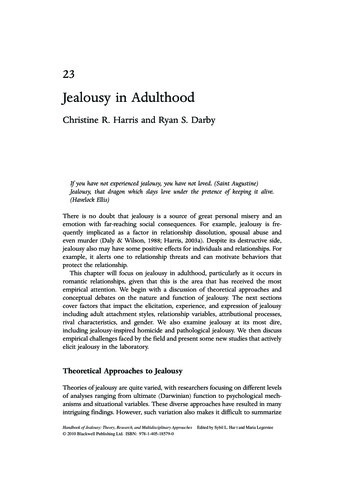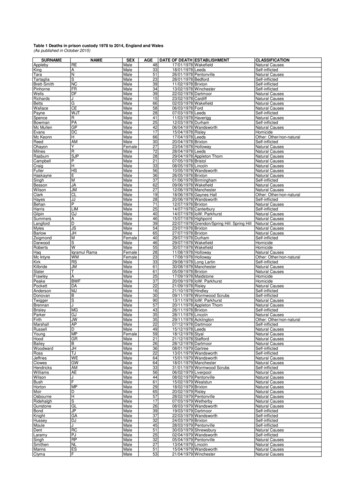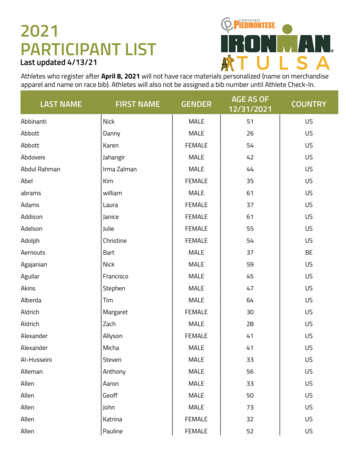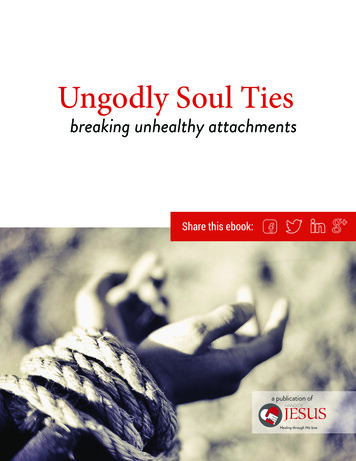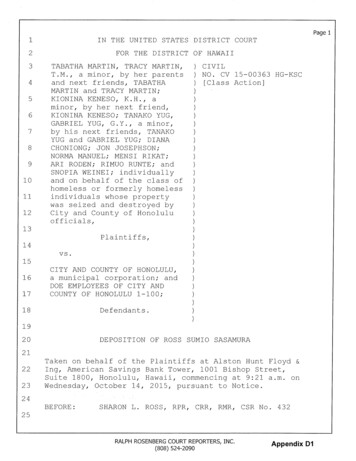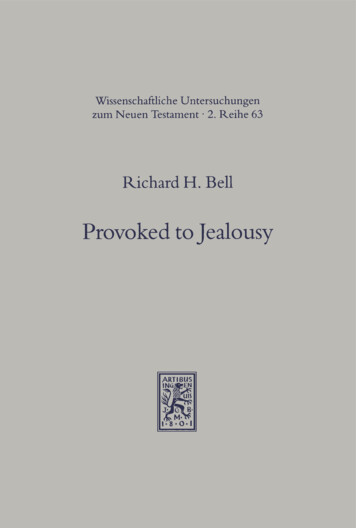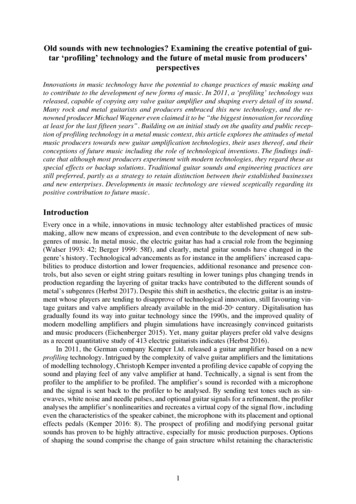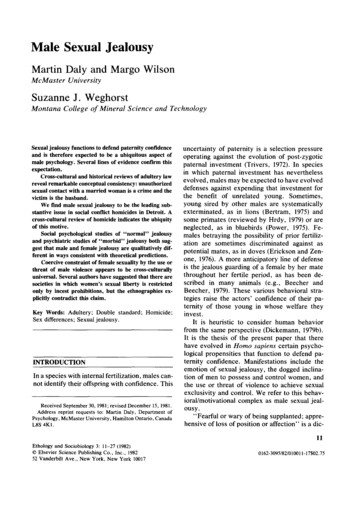
Transcription
Male Sexual JealousyMartin Daly and Margo WilsonMcMasterUniversitySuzanneMontanaJ. WeghorstCollegeof MineralScienceand TechnologySexual jealousy functions to defend paternity confidenceand is therefore expected to be a ubiquitous aspect ofmale psychology. Several lines of evidence confirm thisexpectation.Cross-cultural and historical reviews of adultery lawreveal remarkable conceptual consistency: unauthorizedsexual contact with a married woman is a crime and thevictim is the husband.We find male sexual jealousy to be the leading substantive issue in social conflict homicides in Detroit. Across-cultural review of homicide indicates the ubiquityof this motive.Social psychologicalstudies of “normal” jealousyand psychiatric studies of “morbid” jealousy both suggest that male and female jealousy are qualitatively different in ways consistent with theoretical predictions.Coercive constraint of female sexuality by the use orthreat of male violence appears to be cross-culturallyuniversal. Several authors have suggested that there aresocieties in which women’s sexual liberty is restrictedonly by incest prohibitions, but the ethnographies explicitly contradict this claim.Key Words:Adultery; Double standard; Homicide;Sex differences; Sexual jealousy.INTRODUCTIONIn a species with internal fertilization, males cannot identify their offspring with confidence. ThisReceived September 30, 1981; revised December 15, 1981.Address reprint requests to: Martin Daly, Department ofPsychology, McMaster University, Hamilton Ontario, CanadaL8S 4K1.uncertainty of paternity is a selection pressureoperating against the evolution of post-zygoticpaternal investment (Trivers, 1972). In speciesin which paternal investment has neverthelessevolved, males may be expected to have evolveddefenses against expending that investment forthe benefit of unrelated young. Sometimes,young sired by other males are systematicallyexterminated,as in lions (Bertram, 1975) andsome primates (reviewed by Hrdy, 1979) or areneglected, as in bluebirds (Power, 1975). Females betraying the possibility of prior fertilization are sometimes discriminatedagainst aspotential mates, as in doves (Erickson and Zenone, 1976). A more anticipatory line of defenseis the jealous guarding of a female by her matethroughout her fertile period, as has been described in many animals (e.g., Beecher andBeecher, 1979). These various behavioral strategies raise the actors’ confidence of their paternity of those young in whose welfare theyinvest.It is heuristic to consider human behaviorfrom the same perspective (Dickemann, 1979b).It is the thesis of the present paper that therehave evolved in Homo sapiens certain psychological propensities that function to defend paternity confidence. Manifestationsinclude theemotion of sexual jealousy, the dogged inclination of men to possess and control women, andthe use or threat of violence to achieve sexualexclusivity and control. We refer to this behavioral/motivationalcomplex as male sexual jealousy.“Fearful or wary of being supplanted; apprehensive of loss of position or affection” is a dic11Ethology and Sociobiology 3: 11-27 (1982)0 Elsevier Science Publishing Co., Inc., 198252 Vanderbilt Ave., New York, New York 100170162-3095/82/010011-17 02.75
12Martin Daly, Margo Wilson, and Suzanne J. Weghorsttionary definition of “jealous” (Morris, 1976).Jealousy is thus not defined according to particular behavior patterns, but as a particular experiential state. Behaviors as dissimilar as violence and vigilance may be manifestationsofjealousy. The emotional content of jealousy mayrange from anger to fear to depression, so thatjealousy seems no more readily defined as a specific emotion than as a specific behavior (seeHupka, 1981). For our purposes, jealousy maybest be defined as a state that is aroused by aperceived threat to a valued relationship or position and motivates behavior aimed at countering the threat. Jealousy is “sexual” if the valued relationship is sexual.Our focus on male sexual jealousy may seemarbitrary and sexist, but it can be justified boththeoretically and empirically. Male sexual jealousy, by defending exclusive sexual relationships, functions to elevate paternity confidence.Females, on the other hand, are not susceptibleto misidentificationof young and misdirectedparental care. Even where males do not investpaternally, they compete for the parental investment of females, a limiting resource for theirown reproductive success (Trivers, 1972). It follows that while women may be expected to bejealous of their mates’ allocation of attention andresources, they should not be so concerned withspecifically sexual fidelity as men. That, in brief,is the theoretical rationale for our emphasis onmales. The discussion to follow provides theempirical justification. We present evidence thatmale sexual jealousy has motivated numerousindependentinventions of parallel legal strictures concerning female sexual liberty, and thatmale sexual jealousy is a leading motive in homicide and other acts of violence. We then reviewevidence that men and women may experiencejealousy in qualitatively different ways. Finally,we consider the evidence that male sexual jealousy is-despitethe persistence of claims to thecontrary-across-cultural universal.ADULTERYANDTHELAWWhenever people codify law, it appears that theyconsider some limitation of sexual right and access beyond incest prohibitions to be an appropriate subject for legislation. This is not an obvious or trivial observation,for many socialtheorists have imagined that mankind must oncehave enjoyed a prehistoric sexual communism,and that sexual jealousy is a recent “culturalinvention.”Modern knowledge of animal behavior has exposed the naivete of such ideas;aggressive competition for females and the sequestering of mates from rival males are conspicuous male preoccupations in many species,including mammals. We know of no reason todoubt that males have competed jealously forfemales throughout hominid history. The strikingly similar legal restrictions on sexual behaviors that have been independentlyinvented invarious human societies reflect the fundamentalconflict of reproductive self-interest that inevitably exists among male reproductive competitors.Both cross-cultural and historical reviews ofadultery law reveal a remarkable consistency ofconcept: sexual intercourse between a marriedwoman and a man other than her husband is anoffence. It is often viewed as a property violation. The victim is the husband, who is commonly entitled to damages, to violent revenge,or to divorce with refund of bride-price.Hadjiyannakis(1969) has reviewed the history of European adultery laws, which he suggests have moved only slowly and recently toward legal equality of the sexes. AncientEgyptians, Syrians, Hebrews, Romans, Spartans, and other Mediterraneanpeople definedadultery according to the marital status of thewoman and punished both parties severely,often with death. The offending man’s maritalstatus was irrelevant. The first known legal provision concerning a husband’s infidelity is to befound in a Roman law of 16 B.C., according towhich a man lost the right to confiscate his wife’sdowry for adultery if he too was unfaithful. Maleinfidelity was not criminalized until 1810, andthen in only a very limited way, when a Frenchlaw made it a crime for a man to keep a concubine in his conjugal home against his wifes’wishes. In 1852, Austria was the first countryto institute legal equality between spouses, buteven there the criminal code implicitly considered the cuckolded husband to be the offendedparty, by retaining a provision raising the penalties for adultery if the paternity of a subsequentinfant was thrown into doubt.Bullough (1976) reviewed materials for several other ancient societies: As among Mediterranean peoples, the woman’s marital status defined the offence and the man’s was never at
Male Sexual Jealousyissue in Inca (p. 39), Maya (p. 42), Aztec (p. 44),Tigris-Euphrates(p. 53), Islamic (p. 216), andtribal Germanic (p. 350) law. African legal codesshow the same asymmetry(e.g., Gluckman,1965; Goldschmidt, 1967; Rattray, 1929; Sarbah,1968; Seymour,1970). Chinese (e.g., Lang,1946; Bryan, 1925), Japanese (e.g., Pharr, 1977),and other Far Eastern legal traditions similarlycodified a double standard in adultery, and, untilthe present century, permitted the offended husband violent revenge upon the guilty parties.Besides criminalizingadultery, legal traditions commonly acknowledge that when adultery is discovered, a jealous rage on the part ofthe victimized husband is only to be expected.Jurists may then stipulate that cuckoldry justifies or at least mitigates responsibility for otherwise criminal violence. Even in English law,where homicide by cuckolds has been much lesscondoned than in continental Europe and elsewhere, observation of the adulterous wife inflagrante delict0 has been considered a special provocation, reducing homicide to manslaughter ofthe “lowest degree . . . because there could notbe a greater provocation”(Blackstone1803,Book IV, pp. 191-192). American juries oftendecide that even a reduced charge is excessivelyharsh, and instead vote to acquit homicidalcuckolds altogether on the basis of the “unwritten law,” which is, according to Bouvier’sLaw Dictionary, “a popular expression to designate a supposed rule of law that a man whotakes the life of a wife’s paramour or a daughter’s seducer is not guilty of a criminal offence.”(The reproductive strategic rationale for “jealous” concern with the chastity of daughters israther another matter from that of wives, as isfurther discussed on p. 19 below.) Vance andWynne (1934) cite examples of juries acquittingon the basis of the unwritten law defense despitebeing explicitly instructed by the presiding judgeto disregard this defense and to convict. Thelegal view of the normalcy of jealousy is perhapsbest illustrated by Edwards’s (1954) summarycharacterizationof the “reasonableman” ofcommon law: “. . . he is not impotent and heis not normally drunk. He does not lose his selfcontrol on hearing a mere confession of adultery,but he becomes unbalanced at the sight of adultery, provided, of course, that he is married tothe adulteress.”The double standard is of course often extended to the issue of the legal right to divorce13an adulterous spouse. However, many modernlegal codes have abolished discriminationbetween the sexes on this point. It is of interestthat legal equality in the right of divorce foradultery is not necessarily indicative of a lackof sex difference in the inclination to exercisethat right. Kinsey et al. (1953), for example, reported that 51% of their divorced American malesample considered extramarital intercourse bytheir spouses to be a major factor in their divorces, compared to just 27% of divorcedwomen-eventhough Kinsey’s male interviewees were in fact twice as likely to have committed adultery as were the female informants.A similar though less dramatic pattern is evidentin a recent English survey: 24% of divorced menand 16% of divorced women reported an extramarital affair on their own.parts during marriage,and yet 26% of divorced men and 18% of divorced women cited the partner’s infidelity asa factor in marriage breakdown (Thornes andCollard, 1979). Men seem to be less able or lesswilling than women to forget or forgive a spouse’sinfidelity (see also Levinger 1966; Krupinski,Marshall, and Yule, 1970).Why should men insist that the right of sexualaccess to a woman be exclusive? Why shoulda man wish to dispose of a wife who has committed adultery? Why should the conception ofadultery as a property offense against a husbandhave suggested itself to legislators in such a diversity of human societies? One conceivable rationale for such jealousy might be fear of venereal disease (a motive that should apply towomen as much as to men). Another is the uncertainty about paternity that adultery engenders.Symons (1979, p. 242) points out that positinga major selective role for paternity uncertaintyin the evolution of male sexual jealousy does notimply that paternity must be an overt or conscious concern of jealous men, any more thanof any other sexually jealous male animals. Thisis true, but men are in fact much concerned withpaternity, and the issue has often been raised asa justification for double standards. When JamesBoswell, for example, ventured to Samuel Johnson that “there is a great difference between theoffence of infidelity in a man and that of hiswife,” Dr. Johnson replied, “The difference isboundless. The man imposes no bastards uponhis wife.” (Boswell, 1779, p. 1035). Many legalcommentators have interpreted or justified adul-
14Martin Daly, Margo Wilson, and Suzanne J. Weghorsttery laws on precisely the same basis. Thepreamble to French revolutionary adultery legislation, for example, argued the following:It is not adultery per se that the law punishes, butonly the possible introduction of alien children intothe family and even the uncertainty that adulterycreates in this regard. Adultery by the husband hasno such consequences [our translation of Fenet,1827, quoted by Hadjiyannakis 1969, p. 5021.The relationship between the cognitive suspicion (or knowledge) of nonpaternity and theemotional reaction of jealousy is deserving ofstudy. Certainly case reports in the literatureindicate that such cognitive factors can fan jealous rage. A dramatic example is this killer’s account of the events precipitatinghis wife’sdeath:You see, we were always arguing about her extramarital affairs. That day was something more thanthat. I came home from work and as soon as Ientered the house I picked up my little daughterand held her in my arms. Then my wife turnedaround and said to me: “You are so damned stupidthat you don’t even know she is someone else’schild and not yours.” I was shocked! I became somad, I took the rifle and shot her [Chimbos, 1978,p. 541.SEXUAL JEALOUSY AS A HOMICIDEMOTIVE: DETROIT, 1972The homicide bureau of the Detroit police department investigated 690 nonaccidentalhomicides committed in 1972. By October, 1980, 512of these cases were closed (which means thatthe police had identified a perpetrator to theirown satisfaction, although a conviction or evena prosecution may not have been attained). Police tiles on all 690 homicides were examined indetail during 1973-1974 by M. Wilt, who codedcases with respect to 70 variables, includingages, sexes, victim-offenderrelationship, anda set of conflict typologies of her own devising(Wilt, 1974). We have added further codings,and have updated the data by examination offiles completed since Wilt’s study.Wilt categorized homicides as “crime-specific” (incidental to the commission of anothercrime, usually robbery) or “social conflict.” The512 closed cases included 168 crime-specifichomicides (32.8%), 339 social conflict homicides(66.2%), and 5 unclassifiable cases. Circumstan-tial evidence suggests that a much larger proportion of the 178 cases remaining open arecrime-specific, or, in other words, that althoughonly 74.2% of the 690 homicides are closed, aconsiderably larger percentage of the social conflict cases are closed.“Social conflict” homicides were then divided by Wilt into four categories, atheoreticallyderived from a preliminary reading of a hundredcases, and the cases were further subclassifiedaccording to the applicability of various typological descriptive statements. The four principalcategories she called “jealousy conflict” (58cases, 19.0% of those 306 classified), “businessconflict” (13 cases, 4.2%), “family conflict” (99cases, 32.4%), and “argument between friends,acquaintances or neighbors” (136 cases, 44.4%).The first two categories concern the substanceof the dispute and were given classificatorypriority; remaining cases were then categorizedaccording to the relationship between the victimand offender and further subcategorized according to a large number of substantive issues represented by one or a few cases each. Of interestin the present context is the fact that jealousyappears to be the most frequent substantiveissue in social conflict homicides in this sample(and there is reason to believe-seeOtherHomicide Studies, below-thatsexual jealousyis a motive in many more homicides than policerecords reveal).The 58 jealousy conflict cases are summarized in Table 1 according to the denouementand the identity of the jealous party. Anotherinteresting classification of these cases concernsthe role of a third party: In 40 of the 58 cases,police evidence included an explicit accusationof infidelity or a sexual rivalry. These are whatTable 1. Sexual Jealousy Conflicts Leading toHomicide--Detroit,197247 Cases PrecipitatedJealous Male16 killed female forinfidelity17 killed rival male9 killed by accusedfemale2 killed by accusedfemale’s kin2 killed homosexualmale for infidelityI killed bystanderaccidentallyby 11 Cases PrecipitatedJealous Femaleby6 killed male forinfidelity3 killed rival female2 killed by accused male
15Male Sexual Jealousysome criminologists have called “love triangle”cases. In 30 such cases the jealous party wasmale and in 10 female. In the other 18 cases, itis not clear that any particular third party wasinvolved or even suspected by the jealous individual: one person is simply known to havetaken exception to the other’s terminating therelationship. These cases show an even greatersex difference, with 17 such homicides precipitated by jealous men and only 1 by a jealouswoman.The distinction between a woman’s adulteryand her wanting to end the relationship altogether illustrates two related but discriminablereproductive strategic considerations underlyingmale jealousy. Only the former places the manat risk of misdirected parental investment in another man’s offspring. The commonality that hasled most researchers to lump these as “jealousy” cases appears to reside in the aggressivelyproprietary attitude of the jealous party, whoconsiders both adultery and desertion as loss ofhis exclusive rights over his wife. More ultimately, the important commonality is that theman loses control of female reproductive capacity and hence loses ground in the reproductivecompetition between men.OTHER HOMICIDESTUDIESCriminologistsin the United States and elsewhere have regularly found sexual jealousy tobe a leading homicide motive. Wolfgang (1958),for example, studied police records on 588 Philadelphia homicides and proposed 11 principalmotive categories accounting for 92% of thecases. The most frequent was “altercations ofrelatively trivial origin,” a catchall category ofarguments that accounted for 36% of 560 classified cases. The second leading motive was“domestic quarrels” (15%, most-of these beingspousal disputes with the sources of contentionlittle elucidated). “Jealousy” ranked third (12%).Similarly, in West’s (1968) study of homicidesin Manhattan,sexual jealousy was the thirdranking motive after “unrestrainedrage in thecourse of quarrels” and crime-related murders.Jealousy ranked second to trivial altercations ina Baltimore study (Criminal Justice Commissionof Baltimore, 1967), and second to domesticquarrels in a study of modem Navajo cases inArizona (Levy, Kunitz,‘and Everett, 1969). Similarly, jealousy has ranked third as a homicidemotive behind “quarrels”and “robbery”instudies in England and Wales (Gibson and Klein,1961) and Scotland (Gillies, 1976). Other European studies have also noted the prevalence ofthe jealousy motive (e.g., Sessar, 1975; Horoszowski, 1975).It may well be that jealousy is even moreoften at issue than these studies indicate. In collecting information on “motives,” the police areprimarily concerned to reconstruct the eventsimmediately preceding the homicide. Accordingly, the account of a spousal homicide maybegin with a burnt supper. Similarly, the descriptions of “altercations”between young mengenerallycontainconsiderabledetail aboutweapons produced and threats exchanged, butoften leave the substantive issues unspecified.Perhaps many of these unexplained conflicts areat least partly jealousy conflicts.Our Detroit sample included 80 homicides inwhich the victim and offender were spouses, including common-law relationships (victims were44 husbands and 36 wives).’ Twenty three ofthese (28.8% of spousal homicides) were “jealousy conflicts,” according to Wilt’s classification. Yet, studies utilizing more information thanis generally to be found in police files haveunearthed a much higher incidence of sexualjealousy cases among spousal homicides. Guttmacher (1955), a court-appointed psychiatrist inBaltimore, reported on-36 consecutive familyhomicides, 31 of which were spousal, and tabulated “apparent motivational factors” on thebasis of his interviews of the perpetrators; whilethe data are presented ambiguously, it appearsthat as many as 25 of 31 spousal homicides (ofwhich the wife was the victim in 24) were motivated by sexual jealousy.Similarly, Chimbos (1978) intensively interviewed the perpetrators (29 men and 5 women)’ Roughly equal numbers of victims do not indicate equalviolence by the two sexes. Although husbands were moreoften victims in spousal homicide than were wives, the initialaggressor was usually judged to have been the husband. Mostwives were defending themselves. As a consequence, womenwho killed their husbands were significantly less likely to beconvicted of a criminal offense than were men who killed theirwives. Out of 29 wife-killings in which the final disposition ofthe case was known to us, 15 husbands were convicted ofmurder or manslaughter, 5 were convicted of minor offenses,4 committed suicide, and 5 cases were dismissed (2 for selfdefense). By contrast, of 36 settled husband-killings, only 5wives were convicted of murder or manslaughter, 4 of minoroffenses, and 27 cases were dismissed (22 for self-defense).
16Martin Daly, Margo Wilson, and Suzanne J. Weghorstin 34 Canadian spousal homicides. He reportedthat the main source of conflict in the marriagewas said to be “sexual matters (affairs and refusals)” in 29 (85.3%). Twenty two couples(64.7%) had separated at least once due to infidelity and reconciled. And although Chimbosnowhere breaks down infidelity by sex, thereare 13 allusions to it in quotations from maleoffenders, all concerning female infidelity, and4 allusions from female offenders, all of whichagain concern male accusations of female intidelity. (In one of these cases, the accusationswere mutual.) Six “typical” cases, four perpetrated by men and two by women, are describedin detail, and in all six, the husband accused thewife of infidelity (on good evidence) immediatelybefore the act.Thus, both of these studies, utilizing information beyond that to be found in police files,suggest that male sexual jealousy may be themajor source of conEict in an overwhelmingmajority of spousal homicides in North America.Students of homicide in other cultures alsoreport numerous sexual jealousy cases. Lobban(1972), for example, read court records of homicide cases in the Sudan, and reported that sexual jealousy was the leading motive category,accounting for 74 of the 300 male-offender cases(24.7%). Tanner (1970), in a Ugandan study,found sexual jealousy/adulterycases the mostfrequent homicides after robbery and propertydisputes. Bohannan (1960) collated trial information on 533 homicides among the Tiv, Soga,Gisu, Nyoro, Luyia, and Luo in British colonialAfrica. (We have ignored his Alur sample because of a lack of information on motives.) Hiscapsule descriptions identify 91 (19.1%) as casesof sexual jealousy, adultery, or disputes over awife’s leaving her husband, and it must be notedthat, as in America, most cases were attributedto “drunken arguments” and the like, with thecontentiousissues unspecified.Of 70 wiveskilled by their husbands, at least 32 (45.7%) ofthe attacks involved sexual matters, with 18 foradultery, 11 for leaving their husbands, and 3 forrefusing sex. Only four husbands were killed bytheir wives, none because of the man’s adultery,leaving the woman, or refusing sex (althoughone woman was killed by an irate wife for adultery with the offender’s husband, and threewomen killed co-wives).Several studies of homicide among aboriginalpeople in India, where 99% of offenders are men,again implicate sexual rivalry and jealousy.Among wives killed by their husbands, threeMunda cases included one for adultery and onefor the woman’s desertion of her husband (Saran,1974), three Oraon cases included one for adultery and two for desertion (Saran, 1974), eightBhil cases included one for adultery and four fordesertion (Varma, 1978), and 20 Maria cases included six for adultery, three for desertion, andtwo for refusing sex (Elwin, 1950). Thus themajority of cases in each society was precipitated either by male accusations of adultery orby the woman’s leaving or rejecting the husband.In each of these studies, about 20% of themale-male homicides were, furthermore, due torivalry over a woman or to a man’s taking offence at advances made to a daughter or otherfemale relative.SEXUAL JEALOUSY AND WIFE-BEATINGIt is worth noting the prevalence of sexual jealousy as a motive in nonfatal wife-beating, as wellas in homicide. Miller (1980), for example, interviewed 44 battered wives seeking refuge ina women’s hostel in Windsor, Ontario. Twentyfour women (54.5%) reported that jealousy wasone of the reasons why their husbands assaultedthem. The only other reasons as frequently citedwere the husband’s drinking (29), argumentsover money (28), and conflicts over children(24). Eleven of the 44 women acknowledged actual infidelity on their parts as a cause of theirhusbands’ violence.Whitehurst (1971), also in Windsor, attended100 court cases involving couples in litigationover the husband’s use of violence upon thewife. He reported, without quantification,that. . . “at the core of nearly all the cases . . . thehusband responded out of frustration at beingunable to control the wife, often accusing her ofbeing a whore or of having an affair . . .” Rounsaville (1978) interviewed 31 battered Americanwomen in hostels and hospitals, and reportedthat “jealousy was the most frequently mentioned topic that led to violent argument, with52 percent of the women listing it as the mainincitement and 94 percent naming it as a frequentcause.” (p. 21) Finally, in a study of 60 batteredwives who sought help at a clinic in rural NorthCarolina, Hilberman and Munson (1978) reportthat husbands exhibited “morbid jealousy” such
17Male Sexual Jealousythat “leaving the house for any reason invariablyresulted in accusations of infidelity which culminated in assault” (p. 461) in an astonishing 57cases (95%).We have studied a Bmonth sample of 362case reports by the London, Ontario, FamilyConsultantService. A representativeof thisservice accompanies the police officer on eachfamily crisis call demanding police intervention(Jaffe and Thompson, 1978). In addition to helping resolve the crisis, the consultant completesa standard form at every intervention.In 55 ofthe 362 cases (15.2%), accusations of infidelitywere aired to the family consultant. These included 26 of 244 (10.6%) cases in which the police call had not been precipitated by an assault,compared to 29 of 118 assault cases (24.6%) and,more specifically, 28 of 82 wife-beating incidents(34.1%).Though wife-beating is often inspired by asuspicion or fear of sexual infidelity, it is alsooften the product of a more general jealousy.Battered women commonly report that theirhusbands violently object to the continuation ofold friendships, even with other women, and indeed to the wives’ having any social life whatever (e.g., Dobash and Dobash, 1979; Rounsaville, 1978; Hilberman and Munson, 1978). Inextreme cases, men may refuse to let their wivesgo to the store unescorted, and such husbandsrun the risk, in the Western world, of being psychiatrically diagnosed as “morbidly”or pathologically jealous (e.g., Shepherd, 1961; Mowat,1966; Lagache, 1947). Yet there are societies inwhich such constraint and confinement of womenare considered normal and laudable (see, e.g.,Dickemann, 1979a, 1979b, 1981).We propose that men in all societies experience some inclination to restrict the social intercourse of their mates, and that this generalized jealousy is an evolved attribute that mustbe understood as an anticuckoldry (confidenceof paternity) and sexual competition tactic. Several authors have pointed out that male domination of women is by no means a cross-culturaluniversal (see, e.g., Roger, 1975). We acknowledge cultural differences in the power relationsbetween the sexes but do not consider such variations contrary to our thesis. Obviously societies vary in the degree to which men exerciseeffective control of women, and female economic autonomy is undoubtedly a major determinant of the degree to which women must suc-cumb to male domination.But howeverautonomous the women, men still strive to exertwhat control they can, and there can be littledoubt that fear of male violence constrains thebehavior of countless women the world round.There are several societies in which dangerousmale jealousy has been alleged to be absent, butwe present evidence below (see Jealousy in Sexually Liberal Societies) that these claims are exaggerated.HOW DO THE SEXES DIFFER?We have documented a cross-culturallyconsistent sex difference in sexual jealousy homicides.But, after all, homicide is generally a male activity: 82% of the offenders in our Detroit samplewere male, and most studies of homicide in othersocieties indicate even larger male majorities. Soare men more jealous than women or are theysimply more violent in this sphere, as in allspheres?This question seems hardly to have been addressed, but there is some evidence of sex differences in the quality of jealousy, differencesthat appear consonant with the idea of sex differences in reproductive strategy.Sociob
Sexual jealousy functions to defend paternity confidence and is therefore expected to be a ubiquitous aspect of male psychology. . Book IV, pp. 191-192). American juries often decide that even a reduced charge is excessively harsh, and instead vote to acquit h
